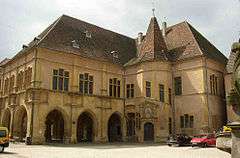Ensisheim
| Ensisheim | ||
|---|---|---|
|
The western side of the town hall | ||
| ||
 Ensisheim | ||
|
Location within Grand Est region  Ensisheim | ||
| Coordinates: 47°51′59″N 7°21′11″E / 47.8664°N 7.3531°ECoordinates: 47°51′59″N 7°21′11″E / 47.8664°N 7.3531°E | ||
| Country | France | |
| Region | Grand Est | |
| Department | Haut-Rhin | |
| Arrondissement | Thann-Guebwiller | |
| Canton | Ensisheim | |
| Intercommunality | Centre Haut-Rhin | |
| Government | ||
| • Mayor (2008–2014) | Michel Habig | |
| Area1 | 36.59 km2 (14.13 sq mi) | |
| Population (2006)2 | 7,034 | |
| • Density | 190/km2 (500/sq mi) | |
| Time zone | CET (UTC+1) | |
| • Summer (DST) | CEST (UTC+2) | |
| INSEE/Postal code | 68082 / 68190 | |
| Elevation |
213–231 m (699–758 ft) (avg. 217 m or 712 ft) | |
|
1 French Land Register data, which excludes lakes, ponds, glaciers > 1 km² (0.386 sq mi or 247 acres) and river estuaries. 2 Population without double counting: residents of multiple communes (e.g., students and military personnel) only counted once. | ||
Ensisheim is a commune in the Haut-Rhin department in Grand Est in north-eastern France. It is also the birthplace of the composer Léon Boëllmann. The Germanic origins of the village's name reflects the area's history.
Among the earliest-known clear examples for the practice of trepanation was identified from a Neolithic burial site near the town. Researchers from Freiburg University reported in 1997 an analysis of the well-preserved skeletal remains of an approximately 50-year-old man, whose cranium showed clear evidence of two trepanation procedures. One had fully healed and the other partially so, indicating the subject had survived the operations. The remains were dated to between 5100 and 4900 BC.[1]
On 7 November 1492, a 250-pound meteorite fell there, and since then it has attracted many meteorite enthusiasts. It was described in detail by the contemporary poet Sebastian Brant.[2] The meteorite can still be seen in the town's museum, the Musée de la Régence.
History
In the remotest times of the Old Neolithic Era, built during the first migration are wares of the Corded Ware culture (the Ribboned Ceramics culture) from Central Europe. With thousand-year old V before B.C., the highly thatched Roofwigs of the large Dannbian Farms of "les Octrois" and Radfeld" were already filling the horizon. The archeological extractions of these Ribboned sites confirm a continuous human occupation from the prehistoric period to Carolingienne agglomeration which developed in the Dannbian Killocks of "les Octrois", however, the origins of Ensisheim still remain rather vague. In 768, the village is mentioned as Enghisehaim.
During the 2nd half of the 13th Century, Rudolph of Habsburg, who reached Imperial Dignity, built the powerful castle of Koenigsbourg. This fortress probably involved the displacement of the primitive village. In 1431, Emperor Sigismund established in Ensisheim the seat of the Austrian Regency and made the city the capital of his possessions in High Alsace, Country of Bade and North of Switzerland..
The 28th of October 1444 the pact to the [Battle of St. Jakob an der Birs] was famously signed in Ensisheim by the Confederation, Zurich and the French Mercenaries.
When on 7th November 1492, a 250-pound meteorite fell into a field close to the town, Sebastian Brant (1458–1521), author of "Das Narrenschiff", took this opportunity to exert his influence on Maximilian of Austria by writing "Loose Leaves Concerning the Fall of the Meteorite", which led the king to lead in a war against France. The administrative and legal functions of the city conferred her to the prosperity which reached its peak between the end of the 16th and the beginning of the 17th centuries. Ensisheim, was mostly a rural community with no more than 200 noble families.

From 1585 to 1634, the city owned a monetary workshop which became the most significant in Alsace after Strasbourg. Nevertheless, as far as the devastating shadow of the "Thirty Year War" (1618–1648) grows, Imperial Administration leave Ensisheim, in 1630. During this dreadful period which falls on Alsace, Ensisheim, will be pillaged 7 times between 1631 and 1638. The tragic consequence of this war would cause the ruin and the decline of the city.
In 1648 after the Treaty of Westphalia, the Habsburg possessions were transferred to the French Crown which ran them by creating a Royal Chamber, then in 1662, the Provincial Council. By that time, Ensisheim was known again as the French province of Alsace, even though this function would be brief. When the imperial troops returned in 1674, the Provincial Council retired in Breisach. The city would be defiantly taken again the following year by Marshall Turenne and a castle would be raised on the grounds in 1682. The departure of the Sovereign Council resulted in the erase of Ensisheim. Now considered as a simple chief town of baillage until the revolution. At the end of the Empire, the city was once again be occupied between 1814 and 1820 by the Cossacks and the Austrians. At the beginning of the 20th century, the development of the extraction of potash led to a new rise for the city of Ensisheim, which still underwent much devastation during world War II. Nowadays, Ensisheim, is a rather significant demographic and economic centre.
Sister cities
Ensisheim has three twin towns:
-
 Markdorf, Germany
Markdorf, Germany -
 Castroville, Texas, USA
Castroville, Texas, USA -
 Otjiwarongo, Namibia
Otjiwarongo, Namibia
It is also a member of the Communauté de communes du Centre Haut-Rhin and of the Pays Rhin-Vignoble-Grand Ballon.
See also
- Meteorite falls
- Communes of the Haut-Rhin département
- Communaute de communes du Centre Haut-Rhin (available in English, German and French languages)
- Pays Rhin Vignoble Grand Ballon (French only)
References
- ↑ Walker (1997).
- ↑ A Contemporary Account of the Ensisheim Meteorite, 1492 Rowland, I. D. (1990), Meteoritics, volume 25, number 1, page 19.
- Walker, Amélie A. (1997). "Neolithic Surgery". Archaeology. 50 (5): 9. ISSN 0003-8113.
External links
| Wikimedia Commons has media related to Ensisheim. |
- Official Website (available in English, German and French languages)
- Ensisheim image gallery (German)

